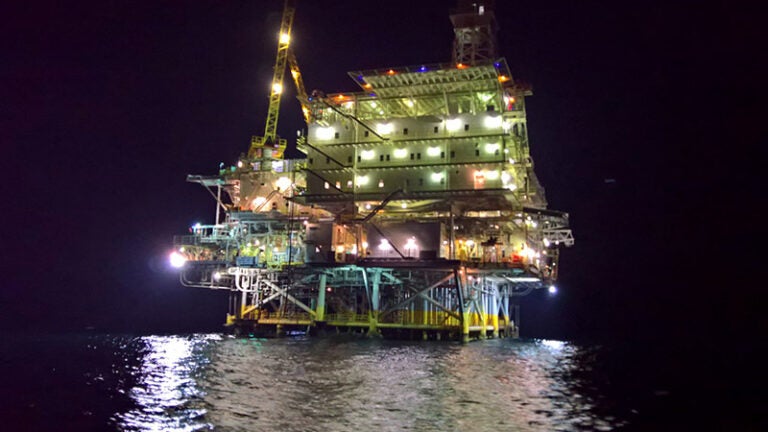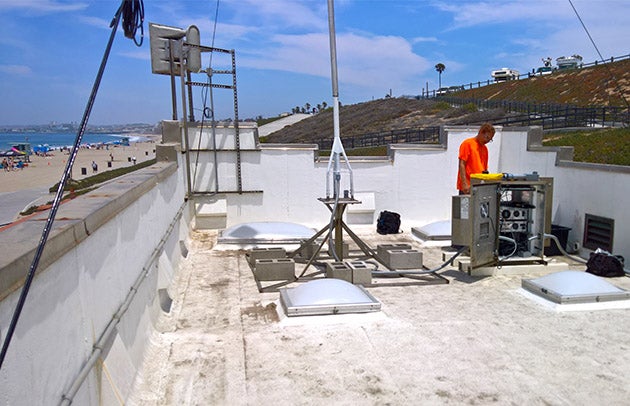
Data from USC Dornsife’s Wrigley Institute helps guide the response to the recent Orange County oil spill
Key takeaways:
- Data from radar stations was critical in confirming the recent oil spill off Huntington Beach, California, and guiding the response.
- Data from the stations is used to build software and models that inform scientists and officials about ocean conditions.
- It also aids search and rescue operations, toxic algae tracking and criminal investigations.
On Oct. 2, the United States Coast Guard received an alarming report: An oily sheen was seen floating on the water off Huntington Beach, California. By the following day, tens of thousands of gallons of crude oil had spilled out of an offshore pipeline in the area, contaminating the surrounding waters and much of the Orange County coastline.
As officials and conservationists scrambled to respond to the spill, they leaned heavily on data supplied by one of the USC Dornsife College of Letters, Arts and Sciences’ research institutes.
The USC Wrigley Institute for Environmental Studies is part of the National Oceanic and Atmospheric Administration’s (NOAA’s) Integrated Ocean Observing System (IOOS), a 24/7 monitoring program that uses radar and other sensors to track ocean currents and the color of the water along the U.S. coastline.
The Wrigley Institute maintains six of the program’s high-frequency radar installations. One radar station is on Santa Catalina Island, 26 miles off the Los Angeles coast. The others dot the coast from Malibu in northwest L.A. County to Newport Beach in Orange County, just south of Huntington Beach — where most of the oil spill emerged and then came ashore.
Data from the Wrigley Institute radar stations feeds to a central database at San Diego’s Scripps Institution of Oceanography, the primary contact for IOOS’s West Coast region.
At Scripps, the IOOS team gathers data from the region and builds software and models — such as surface maps of ocean currents — that officials and scientists can use for information about the Pacific Ocean.

Matthew Ragan of the USC Wrigley Institute maintains a radar station in Torrance, Calif.
“The data we get goes directly into supporting the decision-making process,” says Wrigley Institute Project Manager Matthew Ragan, who monitors the radar station data streams to ensure they are working properly and, along with Wrigley Institute Engineering Technician Carl Oberg, fixes any malfunctions.
“The oil is going to be on the surface, so wherever the current’s going is where the oil is going to go,” Ragan says. “Officials use this data to decide where to send their boats and their booms and which beaches to close.”
The California Department of Fish and Wildlife’s Office of Spill Prevention and Response (OSPR) leads the effort to clear the Orange County oil spill. To help predict where ocean currents — and thus the oil — are likely to go, they use models that draw on both real-time and historic data.
“You have to have historic data built up to get accurate results from these models. That’s why it’s very important to make sure everything is always working, even when there doesn’t seem to be a particular need for it,” Ragan says.
In addition to six IOOS radar stations, the Wrigley Institute maintains an ocean-color sensor on oil platformEureka, 9 miles southwest of the Huntington Beach shore. Data from the sensor feeds into an NOAA program that uses ocean color to help calibrate and validate images from U.S. and European satellites. In the case of the Orange County disaster, such images prompted NOAA to warn officials of a possible spill. Coupled with the Oct. 2 report to the Coast Guard, the warning helped confirm the presence of the spill and its location.
According to Ragan, the Wrigley Institute’s radar data also delivers benefits beyond oil spill response. The Coast Guard uses the information in search-and-rescue operations, to predict the possible location of missing persons and to make the operations themselves safer for everyone involved.
The city of Los Angeles uses the data to help determine the safest times to perform maintenance on outfall pipes, where treated wastewater is discharged into the ocean. And the information is important for safely piloting large vessels into shore, tracking blooms of toxic marine algae that may make beachgoers and wildlife sick, and finding the source point of illegal dumping in the ocean.
That service to society, Ragan says, is what makes his job fulfilling.
“Whether you’re talking about the Coast Guard saving somebody’s life or helping to figure out where the oil is going — those things affect society directly,” he says. “This has real impact.”